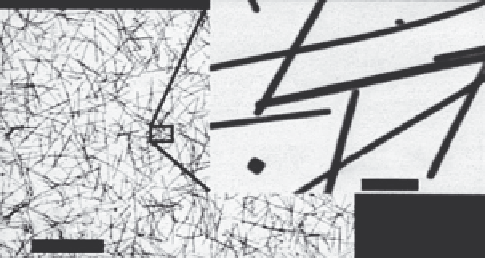Civil Engineering Reference
In-Depth Information
500 nm
10
µ
m
8.14
Scanning electron micrographs of Ag nanowire meshes.
A magnifi cation of the rectangle is shown in the upper right-hand
panel. From J.-Y. Lee
et al.
(2008).
coatings with some degree of optical scattering ('haze') (J.-Y. Lee
et al.
,
2008; Hu
et al.
, 2010).
The fi nal example of nanoparticle production for coatings is one where
work has only recently begun and for which the potential is great though
not yet easy to assess: microbiological preparation. Plate II (between pages
162 and 163) illustrates the growth of silver nanoparticles inside bacteria of
Pseudomonas stutzeri
(Klaus
et al.
, 1999; Klaus-Joerger
et al.
, 2001). It is
remarkable that particles of this kind can be single-crystalline. They can be
used, for example, to make selectively solar absorbing coatings (Joerger
et al.
, 2000). In fact, there seems to be a vast number of organisms that can
serve as eco-effi cient 'nanofactories' and produce inorganic nanoparticles
either intra- or extracellularly, including magnetotactic bacteria, diatoms,
fungi and others (Mandal
et al.
, 2006; Olenin and Lisichkin, 2011; Rai and
Duran, 2011).
The marriage of biotechnology and materials science to make new eco-
effi cient constructions - as exemplifi ed above - is a particularly exciting line
of development, and recent work has demonstrated how viruses can be
harnessed for making nanobatteries (Lee
et al.
, 2009) and nanostructured
solar cells (Dang
et al.
, 2011).
8.3
Large-scale manufacturing
The cost of making thin fi lms and nanostructured coatings is often of the
greatest importance for judging whether they can be used in eco-effi cient
technologies or for other practical applications. The cost inherent in thin
fi lm manufacturing is a complicated issue and depends critically on the
production scale. Thus large-scale manufacturing is essential. One example
where this issue has been developed almost to perfection is for the coating

Search WWH ::

Custom Search